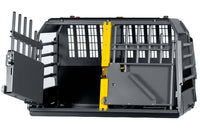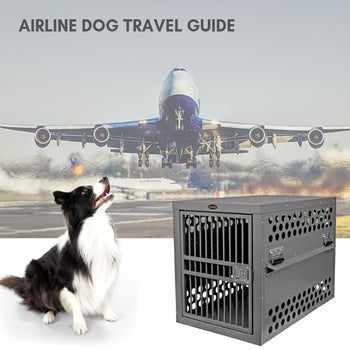
Sizing Guide
How to Measure Your Pet
There are three measurements to take into consideration when choosing the correct size door for your pet, the following guidelines will help you get accurate measurements. If you get stuck or need any help please contact us, our experts are ready to help.
#1 - Measure Width – Simply measure your pet at the widest point and add an inch or two for safety. If your pet is long-haired, don’t forget that this may make them appear wider than they really are. Alternately, you can open a door just wide enough for your pet to pass through and measure the width of the opening, again adding an inch or two for safety.
#2 - Measure Height – The pet door flaps should be at least an inch or two above the top of your pet’s back not the head. To get this length, measure your pet from the withers (top of the shoulders) to the floor. Remember that your door won’t be placed completely at floor level.
#3 - Measure Rise – This measurement is only applicable for panel models which come with the rise built in. Door, wall, screen, and window models can be mounted at whatever height is comfortable for your pet. If you have a short-legged dog or an older dog that can’t lift his feet very high, or if the door is installed with a step on either side, consider ordering a “no rise” door. Our standard rise is 5” or 10”.

Alternate method: You can also make a sample door opening out of a large piece of cardboard based on the above size chart. Place it in a door opening and experiment with height placement. Order the size most comfortable for your pet.
Door Sizing Chart
| Size | Passage Opening | Rough Opening | Outside Frame Dimensions | Shoulder Height | Pet Width | Pet Weight | Breed Example |
|---|---|---|---|---|---|---|---|
| Small | 5 1/2" w x 7 1/2" h | 7 3/8" w x 9 3/8" h | 8 3/8" w x 10 3/8" h | Up to 7" | Up to 4" | Up to 8 lbs. |
 Cats (only very small) |
| Small Medium | 6 1/2" w x 9 1/2" h | 8 1/2" w x 11 1/2" h | 9 9/16" w x 12 9/16" h | 9" - 13" | Up to 5" | 6-12 lbs |
 Most Cats, Chihuahua, Dachshund, Mini Poodle |
| Tall Small Medium | 6 1/2" w x 12 1/2" h | 8 1/2" w x 14 1/2" h | 9 9/16" w x 15 3/8" h | 12" - 15" | Up to 5" | 12-25 lbs |
 Mini Pinscher, Some Terriers, Maltese |
| Medium | 8 1/2" w x 12 1/2" h | 10 1/2" w x 14 1/2" h | 11 9/16" w x 15 3/8" h | 12" - 15" | Up to 8" | 10-35 lbs |
 Terriers, Pug, Corgi, Shiba Inu |
| Tall Medium | 8 1/2" w x 16" h | 10 1/2" w x 18" h | 11 9/16" w x 19 1/16" h | 15" - 20" | Up to 8" | 30-45 lbs |
 Cocker Spaniel, Sheltie, Beagle |
| Large | 11" w x 16" h | 13" w x 18" h | 14 1/16" w x 19 1/16" h | 15" - 20" | Up to 10" | 40-55 lbs |
 Basset, Chow, Keeshond, Husky |
| Tall Large | 11" w x 19 1/2" h | 13" w x 21 5/8" h | 14 1/16" w x 22 9/16" h | 21" - 24" | Up to 10" | 50-95 lbs lbs |
 German Shepherd, Labrador Retriever |
| Tall Large Plus | 11" w x 23 1/2" h | 13" w x 25 5/8" h | 14 1/16" w x 26 9/16" h | 25" - 27" | Up to 10" | Up to 110 lbs |
 Standard Poodle, Irish Setter, Greyhound |
| Extra Tall Large | 11" w x 27 1/2" h | 13" w x 29 5/8" h | 14 1/16" w x 30 9/16" h | 25" - 31" | Up to 10" | Up to 120 lbs |
 Afghan, Irish Wolfhound, Borzoi |
| Extra Large | 14" w x 19 1/2" h | 16" w x 21 5/8" h | 17 1/16" w x 22 9/16" h | 22" - 24" | Up to 13" | Up to 120 lbs |
 Rottweiler, Akita, Bulldog |
| Extra Large Plus | 14" w x 23 1/2" h | 16" w x 25 5/8" h | 17 1/16" w x 26 9/16" h | 25" - 27" | Up to 13" | Up to 150 lbs |
 St. Bernard, Newfoundland |
| Giant | 15 1/2" w x 27 1/2" h | 17 5/8" w x 29 5/8" h | 18 9/16" w x 30 9/16" h | 25" - 31" | Up to 14" | Most Giant Breeds |
 Great Dane, Mastiff, Great Pyrenees |
Other Considerations for Choosing the Correct Door Size
Older pets don’t like to use pet doors that are uncomfortable. Make sure you get a door that your pet will always be able to use. If you currently have a kitten or puppy, remember that they will grow.
Mount the pet door so that it is low enough for your pet to comfortably step over. Young pets can raise their legs up to their chest but older pets may have trouble with this.
Make sure the pet door is tall enough for your pet. Hunching over can be hard on your pet’s hips, especially as they age. And the flaps on your door will last longer if your pet isn’t rubbing against the top of the door as he passes through.
If you have more than one pet, make sure you get a door that will work for all of them: low enough for the shortest one to step over but tall enough for the tallest one to fit through comfortably.
Don’t forget that your pet needs access from both sides of your pet door. If you are installing the door in an area that has steps outside, please take into consideration how your pet will have to get through the door. This is especially true of our panel models. They have a standard rise of 5” but can be ordered with no rise (actually about 1” of frame to step over) instead to make it easier for your pet.


